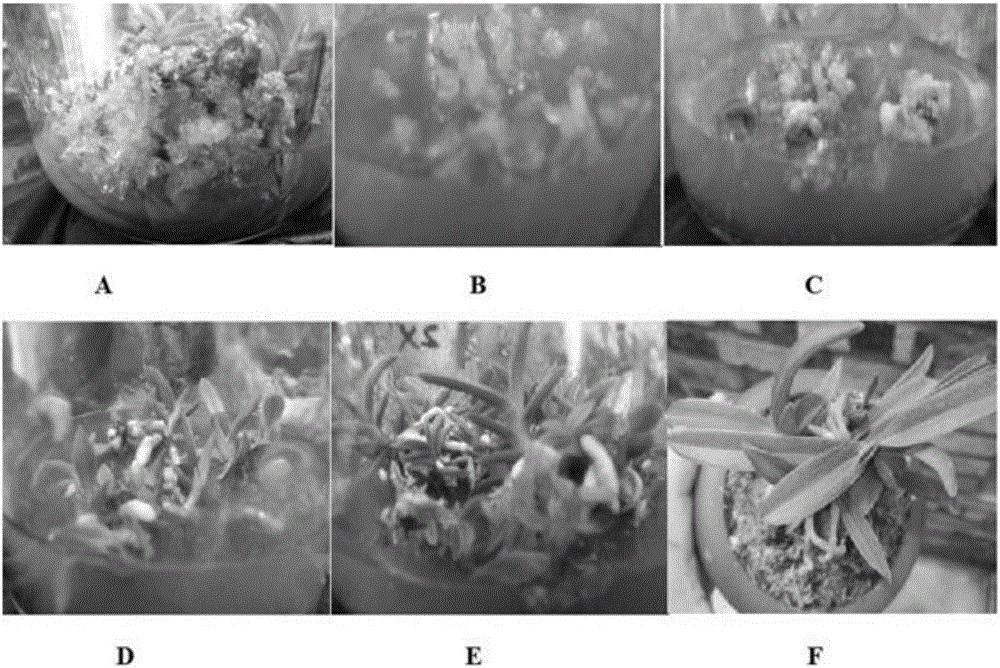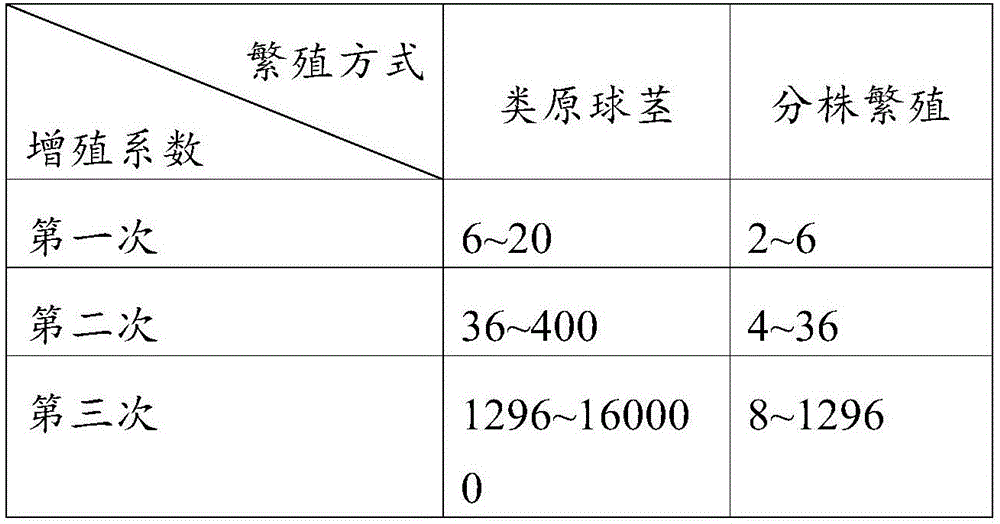Tissue culture rapid propagation method of neofinetia falcate
A tissue culture and phoenix orchid technology, applied in the field of plant reproduction, can solve the problems of low reproduction coefficient, large variation and low reproduction coefficient of phoenix orchid, and achieve the effect of large-scale factory production and stable and consistent genetic traits.
- Summary
- Abstract
- Description
- Claims
- Application Information
AI Technical Summary
Problems solved by technology
Method used
Image
Examples
Embodiment 1
[0047] Step 1, selection and processing of explants
[0048] Select the leaves of the orchid as starting material, and use them as explants for tissue culture after disinfection;
[0049] Step 2, induction of protocorm-like
[0050] On the ultra-clean workbench, transfer the surface-sterilized explants to a sterile inoculation tray, blot the surface moisture of the explants with sterile filter paper, and use sterilized scissors to insert the leaf base down into the protocorm Cultured on the induction medium MS+TDZ5.0mg / L (TDZ: thiadizuron), 20 days later, a yellow embryogenic callus was formed at the base of the leaf, and after another 20 days, it turned from yellow to green, forming a small green ball, which resembled Protocorm formation;
[0051] Step 3, proliferation of protocorm-like
[0052] The protocorm-like formed in step 2 is transferred to the protocorm-like proliferation medium MS+6BA2.0mg / L (6BA: benzylaminopurine) for cultivation, and the protocorm-like prolife...
Embodiment 2
[0058] Step 1, selection and processing of explants
[0059] Select the leaves of the orchid as starting material, and use them as explants for tissue culture after disinfection;
[0060] Step 2, induction of protocorm-like
[0061] On the ultra-clean workbench, transfer the surface-sterilized explants to a sterile inoculation tray, blot the surface moisture of the explants with sterile filter paper, and use sterilized scissors to insert the leaf base down into the protocorm Cultured on the induction medium MS+TDZ5.0mg / L (TDZ: thiadizuron), 20 days later, a yellow embryogenic callus was formed at the base of the leaf, and after another 20 days, it turned from yellow to green, forming a small green ball, which resembled Protocorm formation;
[0062] Step 3, proliferation of protocorm-like
[0063] The protocorm-like formed in step 2 is transferred to the protocorm-like proliferation medium MS+6BA2.0mg / L (6BA: benzylaminopurine) for cultivation, and the protocorm-like prolife...
Embodiment 3
[0069] Step 1, selection and processing of explants
[0070] Select the leaves of the orchid as starting material, and use them as explants for tissue culture after disinfection;
[0071] Step 2, induction of protocorm-like
[0072] On the ultra-clean workbench, transfer the surface-sterilized explants to a sterile inoculation tray, blot the surface moisture of the explants with sterile filter paper, and use sterilized scissors to insert the leaf base down into the protocorm Cultured on the induction medium MS+TDZ5.0mg / L (TDZ: thiadizuron), 20 days later, a yellow embryogenic callus was formed at the base of the leaf, and after another 20 days, it turned from yellow to green, forming a small green ball, which resembled Protocorm formation;
[0073] Step 3, proliferation of protocorm-like
[0074] The protocorm-like formed in step 2 is transferred to the protocorm-like proliferation medium MS+6BA2.0mg / L (6BA: benzylaminopurine) for cultivation, and the protocorm-like prolife...
PUM
 Login to View More
Login to View More Abstract
Description
Claims
Application Information
 Login to View More
Login to View More - R&D Engineer
- R&D Manager
- IP Professional
- Industry Leading Data Capabilities
- Powerful AI technology
- Patent DNA Extraction
Browse by: Latest US Patents, China's latest patents, Technical Efficacy Thesaurus, Application Domain, Technology Topic, Popular Technical Reports.
© 2024 PatSnap. All rights reserved.Legal|Privacy policy|Modern Slavery Act Transparency Statement|Sitemap|About US| Contact US: help@patsnap.com









